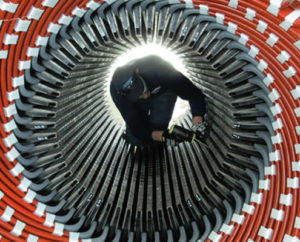Generator Services
TGM offers extensive experience with turbine generators and related equipment from a vast number of manufacturers.
The GRIP® Program
 The inputs to the GRADE® program are testing and assessment options called Generator Reliability Inspection Program (GRIP) 1, 2 and 3. The GRIP® inspections are built around outage durations for typical turbine inspections; thus the generator never becomes the critical path of the outage unless an outage is planned specifically to address major maintenance on the generator (a stator or rotor rewind, for example)
The inputs to the GRADE® program are testing and assessment options called Generator Reliability Inspection Program (GRIP) 1, 2 and 3. The GRIP® inspections are built around outage durations for typical turbine inspections; thus the generator never becomes the critical path of the outage unless an outage is planned specifically to address major maintenance on the generator (a stator or rotor rewind, for example)
GRIP® 1: This rotor-in inspection program is designed to fit in a short turbine outage window of 1-2 days.
- Reveals pending faults in windings of the stator, rotor and exciter
- Reveals deterioration of stator winding insulation caused by partial discharge activity or end winding vibration
- Establishes a baseline for evaluating future inspections and input for establishing planned major maintenance activities
- Written and digital documentation of critical generator components for planning future maintenance
GRIP® 2: This rotor-in inspection program is designed to fit in a 3-4 day turbine outage window. In addition to GRIP® 1 benefits,
- Reveals additional data on armature winding insulation integrity to more accurately assess life and future maintenance requirements
- Reveals assessment of end winding stability (resonance conditions can be immediately corrected to avoid premature winding deterioration)
- Record of core tightness
- More complete documentation for planning future maintenance
GRIP® 3: This rotor-out inspection is designed to fit in a Major Inspection turbine outage window. In addition to GRIP® 1 & 2 benefits,
- Reveals partial discharge activity and deterioration in windings, blocking and core tightness which were obstructed by a rotor-in examination
- Record of stator core lamination condition
- Record of rotor retaining ring, wedge and rotor body condition
- Essential documentation to establish a trend report to monitor future deterioration
- Turn-Key and Field Based
Repair Services
To keep outage windows at a minimum, our generator service group is turn-key and field based, providing stator and rotor inspections and most repairs at the plant site. Some common repairs include:
- Stator re-wedging
- Rotor retaining ring removal / replacement
- Stator core repairs
- End winding repairs
- Rotor and Stator Rewinds
- CO2 dry ice blasting
The GRADE® Program
With over 25 years of servicing steam and gas turbines in the cogeneration and independent power segments, TGM® has developed a service philosophy of providing customers options to support their availability goals while protecting the reliability of their assets: We believe it is imperative to inspect the generator as often as the turbine and turbine auxiliaries. We believe that generator inspections can be performed concurrently with turbine inspections, without impacting schedule. Finally, we believe that with a frequent and structured inspection and maintenance program, costly unplanned generator outages can be largely avoided.
It is with this philosophy that TGM® has developed our GRADE® Program (Generator Reliability Assessment & Diagnostic Evaluation). GRADE® is the leading generator evaluation program in the industry and the only one that provides not just a snapshot of the generator’s condition but recommendations to achieve long term availability through current and future maintenance and upgrades. The GRADE® program is a proprietary algorithm which outputs a letter grade assessment, just like we all received in school. It is a quantifiable condition-based score with respect to the expected service life of the generator.
“A” (3.5-4.0) means outstanding condition:
Generator in new or like-new condition. Recommendations: No work required. Continue to operate and maintain the generator at better than the OEM’s O&M specifications.
“B” (2.5-3.49) means good condition:
Generator is clean, well-operated and maintained. Aging is less than that associated with a generator with comparable hours of operation. Recommendations: Minor cleaning recommended. Continue to operate and maintain the generator at better than the OEM’s O&M specifications.
“C” (1.5-2.49) means average condition:
Generator is moderately contaminated and/or in need of minor rehabilitation (either now or at the next scheduled outage). Suitable for service with the degree of aging discovered generally equivalent to the generator’s hours of operation. Recommendations: Cleaning and/or remedial work recommended. Continue to operate and maintain the generator at better than the OEM’s O&M specifications.
“D” (1.0-1.49) means unsatisfactory condition:
Generator is heavily contaminated and/or in need of significant and immediate rehabilitation. Generator is operational, though the degree of aging discovered is significant. Generator is reaching the end of its current useful life. Recommendations: Significant cleaning and/or rehabilitation work highly recommended. Immediate attention required in order to stop premature aging. Operation at reduced load may be required in order to extend life.
“F” (0.0-0.99) means failing condition:
The generator has either been discovered to have failed in service or during assessment. Generator is inoperable in its current condition. Recommendations: Generator component rebuild required before the unit can be operated.
